 A couple of years ago I looked at the number of Assistant Directors on Hollywood films. I want to return to the topic as I now have more data, I can add the UK figures into the mix and because I have conducted interviews with over 30 working 1st ADs in the UK and US to get the human perspective. Today, I’ll be looking at the data and next week I’ll share the views and opinions of 1st ADs.
A couple of years ago I looked at the number of Assistant Directors on Hollywood films. I want to return to the topic as I now have more data, I can add the UK figures into the mix and because I have conducted interviews with over 30 working 1st ADs in the UK and US to get the human perspective. Today, I’ll be looking at the data and next week I’ll share the views and opinions of 1st ADs.
The Assistant Directors department are the people who make sure the film actually gets shot and that the whole production stays on schedule. The role is typically split into three classes…
 First Assistant Director (1st AD) runs the department and is one of the most senior ‘below the line‘ crew members.
First Assistant Director (1st AD) runs the department and is one of the most senior ‘below the line‘ crew members.- Second Assistant Director (2nd AD) works directly underneath the 1st AD and is primarily responsible for timing all of the elements the set will need in the upcoming hours and days. They also produce the paperwork that cast and crew members need in order to know when and where to show up, such as the Call Sheet.
- Third Assistant Director (3rd AD) does all of the tasks for the 1st AD and 2nd ADs, including communication, crowd control, moving actors between hair/makeup/etc and the set, managing extras and pretty much anything else which is needed to ensure the 1st AD can keep the production on schedule.
Despite this neat hierarchy, the nitty gritty of credits within the Assistant Directors department can get complicated. Credits can include a ‘Second Unit Daily Assistant Director‘, a ‘Second Second Second Assistant Director‘, an ‘Additional Third Assistant Director for the additional photography‘ to give just three examples. The film Hero had a fourth, fifth, sixth and even a seventh AD.
In order to study AD credits, I started with two datasets – all feature films shot in the UK between 2005 and 2014, and the top 100 US-grossing feature films between 1994 and 2015. I removed documentaries and animations, as these films have different relationships with the AD department. This left me with 2,022 UK films and 2,030 US films to study. I then grouped the credits into the three broad categories I have listed above.
How many Assistant Directors work on a film?
 Of the 2,022 films shot in the UK over a ten-year period, there were 2,977 First Assistant Director (1st AD) credits, 2,766 Second Assistant Director (2nd AD) credits and 2,559 Third Assistant Director (3rd AD) credits. That means that on average each film had 1.5 1st ADs, 1.4 2nd ADs and 1.3 3rd ADs. In addition, there were 300 credits going to training and internships roles within the Assistant Directors department
Of the 2,022 films shot in the UK over a ten-year period, there were 2,977 First Assistant Director (1st AD) credits, 2,766 Second Assistant Director (2nd AD) credits and 2,559 Third Assistant Director (3rd AD) credits. That means that on average each film had 1.5 1st ADs, 1.4 2nd ADs and 1.3 3rd ADs. In addition, there were 300 credits going to training and internships roles within the Assistant Directors department
Within top US-grossing films (1994-2015), the numbers were higher, with an average of two 1st ADs, four 2nd ADs and 1.7 3rd ADs per film. There were also over three times the number of trainees (1,088) despite the fact that my datasets contain almost exactly the same number of films (UK = 2,022 films, US = 2,030 films).
I’m not sure why US films have so many more trainees than UK films, but two good reasons could be that US films are much more unionised than UK films, and that the US dataset includes much larger films (more on that below). ‘The Da Vinci Code‘ had 17 trainees within the AD department, although the average on the US films was 0.5 trainees per film.
It seems that AD departments are growing over time, with the high point for AD average employment coming in 2010.
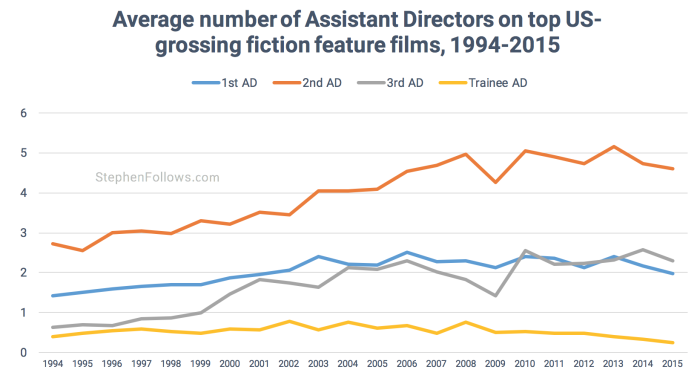
The bigger the movie, the greater the number of Assistant Directors
Unsurprisingly, films with bigger budgets hire more Assistant Directors. This will be for a mixture of reasons including: more people on set to manage, more complicated scenes to film and the ability to have a full complement of crew (unlike the lowest budget films where one person might have to do the work of a few people).
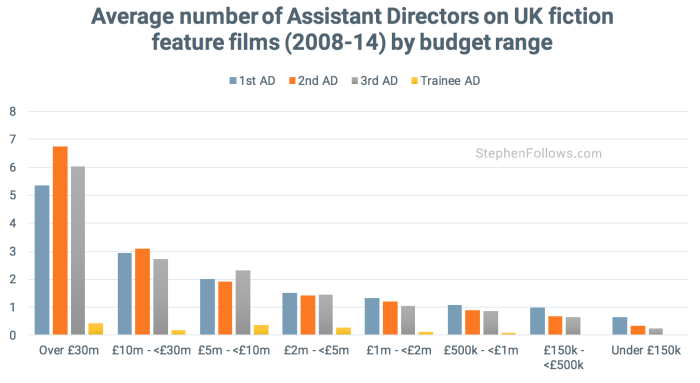
As budgets increase, the biggest growth within the Assistant Directors department is among 2nd ADs, with the largest films hiring an average of nine Second ADs across all filming.
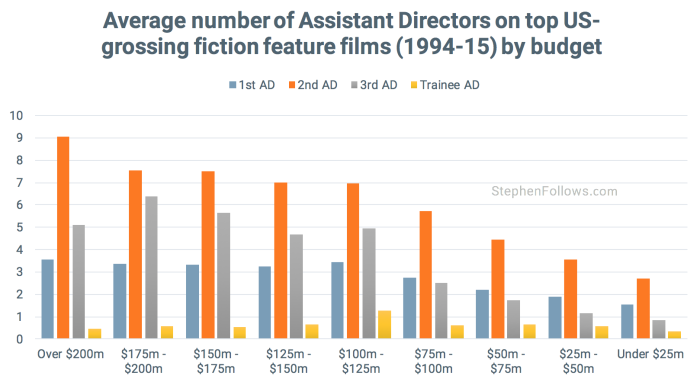
Adventures need ADs, and without them it’s a Horror
Turning to genre, we can see that films with high levels of adventure, action and fantasy require the largest number of ADs. The genres with the smallest AD departments include horror, drama and thriller.
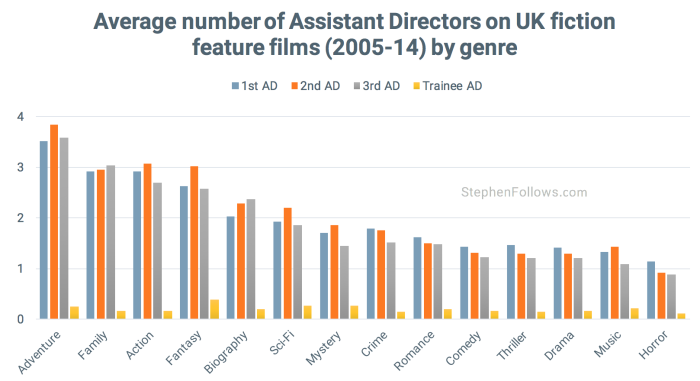
A similar pattern can be found amongst the US films.
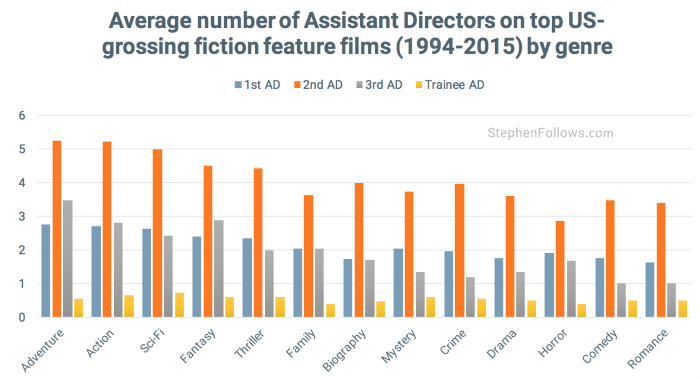
Most Assistant Directors are men
We can’t tell too much about the ADs from the outside (such as age, race, experience levels, etc) but we are able to ascertain their gender. Like most crew members in the film industry, there is a heavy male skew and as we move up in seniority, we see an even greater number of roles going to men.
90% of 1st ADs on top US-grossing films are men, as are 83% of 1st ADs on UK films. Trainees are much closer to gender equality, with men making up 57% of trainees in the US and 59% in the UK.
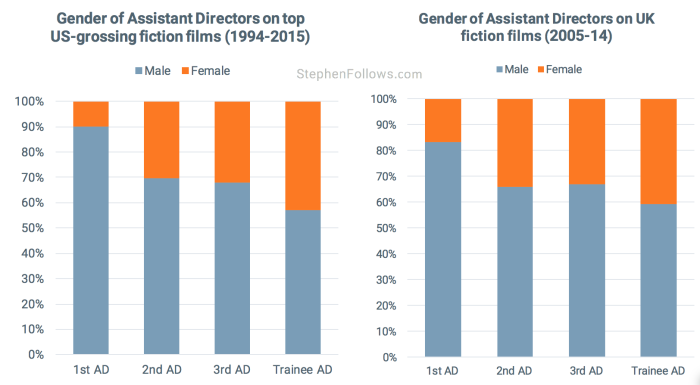
Over time, we can see that the gender makeup of the AD departments on both UK films and top US-grossing films has not shifted much.
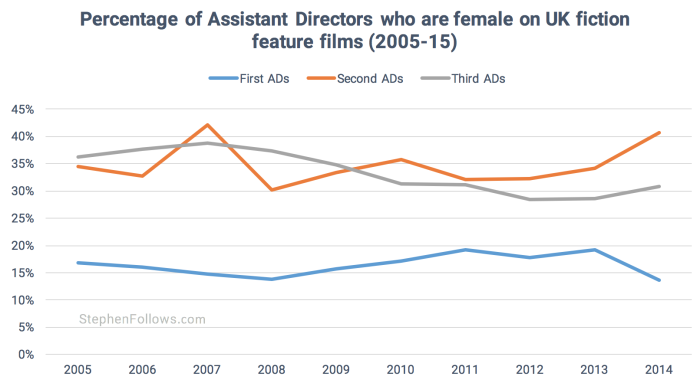
The picture is the same for top US-grossing films.
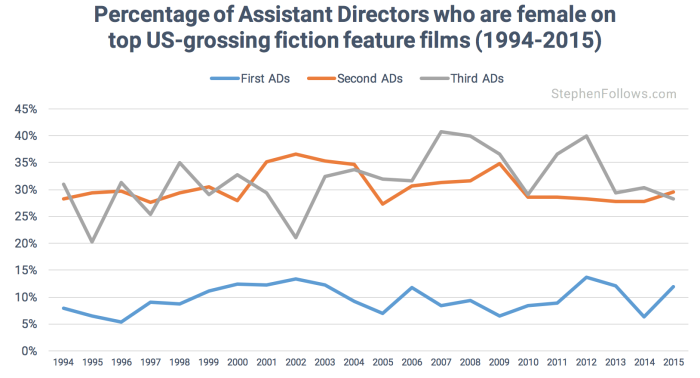
N.B. I left off US trainees as there are too few to study over time.
Notes
As with any such research project looking at crew credits, sadly I cannot measure the input each person put into the film. Therefore, someone who worked for just a few days as a film’s 1st AD will appear to be the same as someone who 1st’ed the film for months. Likewise, 1st ADs on the Second Unit will also appear as ‘1st AD’ in these calculations.



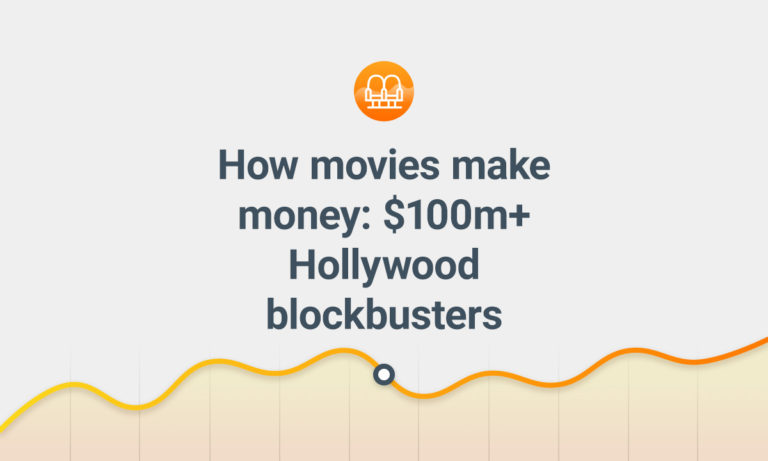

Comments
You continue to compare apples to oranges after you picked out the rotten ones. You only use statistics for top 100 grossing US films but for British films you include all off them. Your choice to leave out documentary films in the statistics despite complaints you have received about that in the past is consistant with your choices in ALL your other survey articles so I am not buying your explanation. Since we all know the duties of a 1st, 2nd, or 3rd AD will vary greatly between a $200 million US film and those same jobs on a 300,000 £ UK film your choice to leave out doc films just because the duties may vary is BS. This all seems designed to make it look like women in the US have it far worse compared to the UK than they do. At least tell us what percentage of total AD jobs in the US are represented just by the top 100 grossing non doc or animation US films. I know women will have much better statistics for doc films in US but that is a fact you seem determined not to be the one to reveal. Are you angling for paid speaking engagements at women’s rvents? While you are at it, how about doing gender statistics for paid positions at US film festivals. Unfortunately it has gotten to the point that articles like yours that refer only to statistics for the top 100 grossing US films have become an old saw used to justify open discrimination against hiring men, even minorities, for all films, even for docs or films, like most that are not the top 100, and for film festivals. How would the UK measure up in race or sexual preference statistics?
Mark
Thank you for your comment, and for the emails and other comments. Part of the reason I research and write this blog is to look at the film industry from multiple angles, and therefore debate is always welcomed.
You raise some good points, in that studying just the top grossing films will indeed only paint the picture of one side of the industry. This is why I included all films shot in the UK. Not to compare the two, but to give two lenses through which to view the topic.
Hopefully the language I’ve used, and the clear explanations of what is being measured, will give readers enough information to be able to judge whether or not they agree with my methodologies.
I tend to look at the top grossing films for a number of reasons. Principally they represent some of the biggest and most culturally-impactful films in a given year. In addition, using this method it is possible to go back a number of decades and still have enough data to study the full dataset. I haven’t yet found a reliable dataset of all films produced in the US, and even if one were to exist I doubt it would allow me to go back twenty years to look for trends.
We’re lucky that in the UK we have the BFI tracking all films made. Therefore, I always default to this dataset for UK films, instead of picking just the highest grossing films in the UK. So you’re right to say that’s this method is imperfect, but I don’t feel I’ve chosen it over a more reliable method and I don’t feel I have a choice.
In the case of this research into ADs, I think I’m justified in removing animations and documentaries as their relationships with the AD department is very different to that of live action fiction films. An AD on a documentary will have very different responsibilities and control than on a fiction production.
However, in order to test your suggestion that my choices have influenced the results I have gone back and crunched a new set of numbers.
I look at all films released in US cinemas (i.e. grossed at least $1) between January 2011 and December 2015 inclusive. I did not remove any films, so this will include animations and documentaries. The result was that 12.1% of 1st ADs are female, 29.8% of 2nd ADs and 32.7% of 3rd ADs. These figures show a slightly higher percentage of female, but not a million miles away from the top grossing live action films.
Based on my other research, I would say that is due to the fact that smaller films tend to have a slightly higher percentage of women in the crew, as do documentaries compared with live action.
In answer to your question about why I measure gender as opposed to race or sexual preference, it’s that gender can largely be ascertained from the outside, whereas race and sexual preference cannot. If I could objectively measure either from the outside I assure you I would. (Plus, for better or for worse, our society has more narrow definitions of gender than of race and sexual preference, making it easier to measure in a binary manner, rather than locating everyone on a spectrum).
And finally, your suggestions that I research gender statistics because I am in receipt of money from female pressure groups is just not correct. I don’t get paid to speak at film festivals, and in fact that vast majority of my speaking engagements are about the film industry more generally. The single time I have received support for gender-focused research is in my upcoming independent report into female directors. The funders (a) are not a “feminist” pressure group (b) had not control of what we studied, what we concluded or what was included.
Finally, by sharing my methodology and being clear about what’s being illustrated, I think I am being as open and independent as I can be.
As I mentioned at the top, thank you for adding to the debate and I hope that this new information has informed your opinion.
Stephen